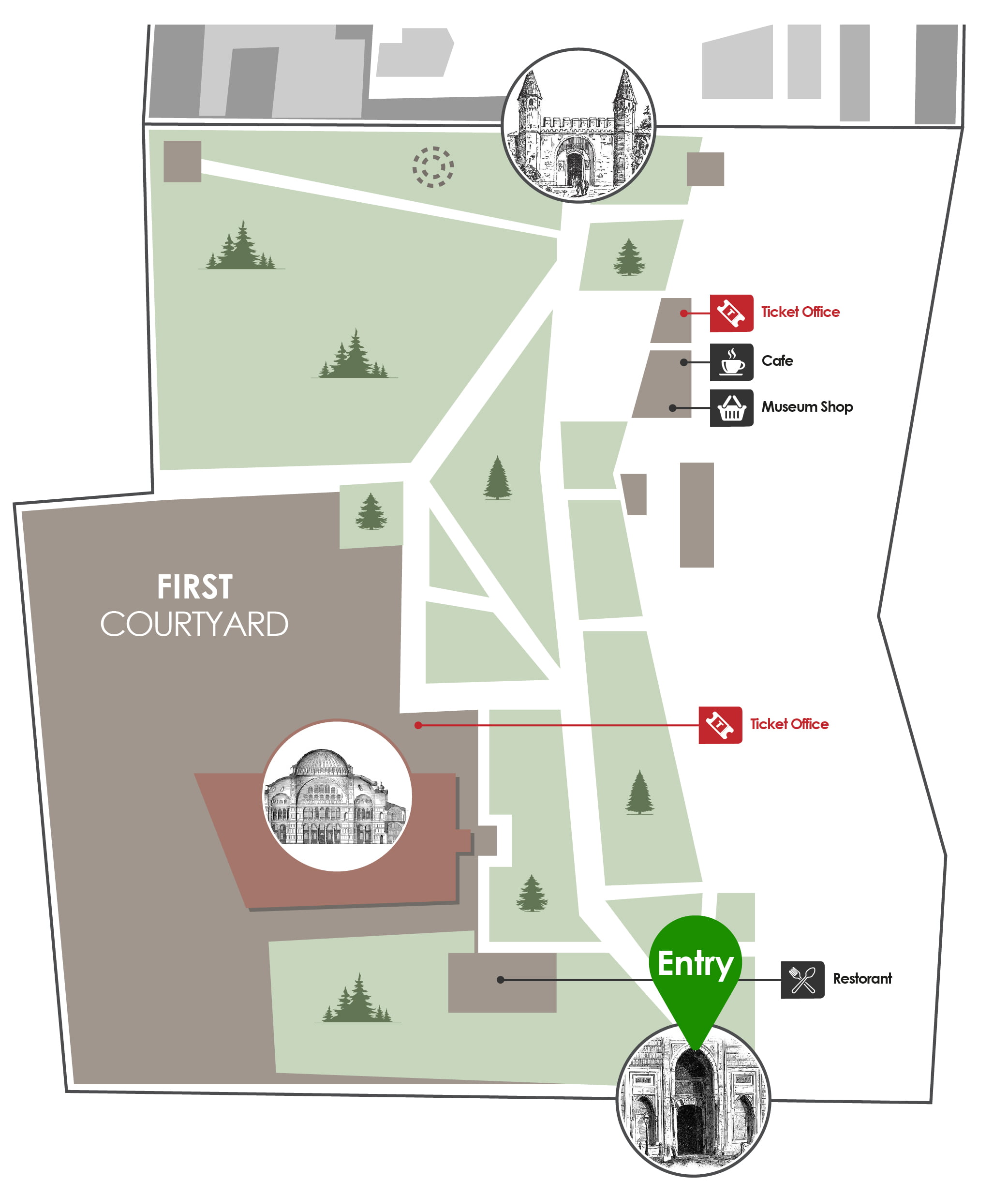Discover Topkapi Palace Museum
Learn about the Treasures, Collections, History & More
History and Architecture of Topkapi Palace
HISTORY
Topkapı Palace was built by Sultan Mehmed II (1444-1445 and 1451-1481) during the years 1460-1478, following the conquest of Istanbul. New buildings and annexes were added by other sultans over the centuries, creating the palace complex as we know it today. The site on a headland at the southern mouth of the Bosphorus was originally known as Zeytinlik (Olive Grove), and here work began with laying out gardens and building pavilions, after which the site was surrounded by walls known as the Sûr-ı Sultânî or Kal‘a-i Sultânî.
For many years this palace was called the New Royal Palace, to distinguish it from the earlier palace in the district of Beyazıt, but later on it became known as Top Kapısı Palace after a pavilion known as Toplu Kapı (Cannon Gate). The palace remained the sultan’s main residence and center of government until the mid-19th century. By the 1840s, the palace had become inadequate for the needs of state protocol, and Dolmabahçe Palace was built in 1843-1856 as the new official residence and administrative center of the empire.
On 3 April 1924, shortly after the Republic of Turkey was established on 29 October 1923, Topkapı Palace became a museum; the first to be established in the Republican period. Today the palace and its grounds cover an area of nearly 350,000 m², excluding Gülhane Park, which was once part of the palace gardens but is now a public park. This palace, with its historic buildings, collections and nearly 300,000 archive documents, is one of the largest museum-palaces in the world.
Topkapı Palace is situated in one of the oldest parts of Istanbul; the historic peninsula bound by the Marmara Sea, the Bosphorus Strait and the Golden Horn inlet. It is one of the city’s most iconic buildings, covering an area of 700,000 m² on the headland known as Sarayburnu, which was previously the site of the Eastern Roman acropolis. Topkapı Palace was the center of Ottoman government, education and art for nearly four centuries, until the reign of the 31st Ottoman sultan Abdülmecid (r. 1839-1861), as well as the sultan’s official residence. Although the sultans lived at Dolmabahçe Palace from the middle of the 19th century onwards, Topkapı Palace retained its historical and symbolic importance.
The palace proper consists of buildings for diverse purposes opening onto a series of large courtyards surrounded by colonnades; a plan that was influenced by the earlier royal palace in Edirne, the former capital. The service buildings are made of stone and mostly single-story with high domes, while the residential buildings are mostly made of stone and wood, with lead-covered domes. The inner parts of the palace and the gardens are ornamented with diverse fountains and pools, and contain numerous water reservoirs.
In terms of its organization the palace is composed of four sections: the Bîrun, or Outer Palace, consisting of service buildings and guard posts; the Dîvân-ı Hümâyun or State Council building, which was the administrative center of the empire; the Enderûn or Palace School; and the Harem, which was the sultan’s private home. There are three main gates in the palace walls, which adjoin the Byzantine city walls: the Bâb-ı Hümâyun or Royal Gate, which is the main entrance, the Demir Kapısı or Iron Gate and the Otluk Kapısı or Hay Gate. There are also five small service gates.
The Bâb-ı Hümâyun is a monumental two-story structure with an inscription bearing the signature of the calligrapher Ali b. Yahyâ es-Sûfî. This leads into the first courtyard, from which a second portal, the Bâbüsselâm, the Gate of Greeting, leads into the second courtyard, from which a third portal, the Bâbüssaâde or Gate of Felicity, leads into the third courtyard, from which a passageway leads into the fourth courtyard. All of these are surrounded by buildings and gardens. The first courtyard is an open square known as the Alay Meydanı or Procession Square, surrounded by the Church of Saint Eirene, the Mint, the Bakeries, Hospital, Firewood Storage and the building housing the Company of Reed Mat Makers, who wove the mats that covered floors throughout the palace.
The second courtyard, known as Divan Square or Justice Square, was the scene of innumerable ceremonies over the centuries. Here were the buildings relating to state government: the Council Chamber known as Kubbealtı or Divan-ı Hümâyûn where the Council of State convened, and the Council of State Treasury. Behind the Divan building was the Tower of Justice and next to it the entrance to the Harem, as well as the Dormitory of Tressed Halberdiers and the Royal Stables.
Around the third or Enderun Courtyard are numerous small and large rooms comprising the sultan’s Audience Chamber, the halls of the Falconers, the Expeditionary Force, the Pantlers, the Enderûn Treasury and the Privy Chamber (today the Apartment of Holy Relics), and the building belonging to the Palace School. To either side of the Gate of Felicity are the dormitories inhabited by the members of the sultan’s household; beyond them on the right the treasury known as the Pavilion of the Conqueror. In the left corner was the Privy Chamber, a four-domed stone building adjoining the Harem, which was more often known as the Apartment of the Holy Mantle after Sultan Selim I brought the holy relics to Istanbul in the early 16th century.
In the fourth courtyard are several royal pavilions, the İftariye Gazebo and terraced gardens. The Baghdad and Revan pavilions are exquisite examples of classical Ottoman period pavilion architecture. The Sofa Pavilion, also known as Kara Mustafa Paşa Pavilion, is thought to have been built in the 18th century and adjoins the wall of the Tulip Garden. Inside this wooden pavilion and at the top of the exterior walls are couplets written by the renowned Ottoman poet Hâkânî Mehmed Bey. On rare occasions ambassadors and statesmen were received in this pavilion. To the right, situated a terrace, is a room known as the Stone Tower that was once used as the palace pharmacy. In the lower part of the fourth courtyard are the last buildings ever added to the palace, the Mecidiye Pavilion and the Wardrobe Chamber.
TOPKAPI PALACE COLLECTIONS
Collections of Topkapi Palace
Discover the treasures of the Ottoman Empire at Topkapi Palace!
Explore the palace's historic buildings and extensive collections, including intricate jewelry, ornate ceramics, and finely crafted weapons. Learn more about the empire's wealth and opulence through these fascinating exhibits.
Eating and Drinking at Topkapi Palace Museum

FIRST COURTYARD
The Konyali 1897 Lokantasi restaurant, located within the first courtyard near Hagia Irene, serves traditional Ottoman cuisine. Visitors to the Topkapi Palace can enjoy a range of dishes that showcase the flavors and ingredients of the Ottoman Empire.
There are two cafe options available for visitors to the Topkapi Palace. The first is the Museum Coffee Shop, which is located near the ticket office and has a few tables, where hot and cold drinks are served.
The second is the cafe inside the Museum Shop, which offers sandwiches and cold and hot drinks in a large space with plenty of tables. Both of these cafes provide a convenient and comfortable place to rest and refresh during your visit to the palace.

SECOND COURTYARD
The second courtyard of the Topkapi Palace is home to two cafes. The first, located near the imperial palace kitchen, is a kiosk-like cafe with a few tables where visitors can rest and enjoy sandwiches and cold and hot drinks.
The second cafe is located on the way to the third courtyard, but still within the second courtyard. This cafe is a buffet-style establishment with no tables, offering only cold and hot drinks to go.
Both of these cafes provide a convenient and refreshing stop during your visit to the palace.
Shop Area of Topkapi Palace Museum
The official museum shop of the Topkapi Palace is located in the first courtyard, on the right side, just before the ticket office. Visitors to the shop can browse a wide range of unique and authentic items that are inspired by the history and culture of the Ottoman Empire.
Our shop is stocked with souvenirs, gifts, and collectibles that are perfect for any traveler or history buff, including ceramics, magnets, Ottoman costumes, cloth, jewelry, handcrafted items, books and much more. Don't miss this opportunity to take home a unique and authentic reminder of your visit to the Topkapi Palace.
Moreover, there is a cafe located inside the museum shop that offers visitors the chance to rest and refresh with a variety of hot and cold beverages and snacks. We hope that you will take the opportunity to enjoy this welcoming space during your time at the Topkapi Palace.





